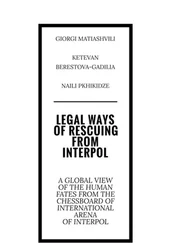It was in a jail house, of all places, where something de-veloped that was, in the final analysis, to trip up Doctor Bol-ber. There was a fellow named George Meyer, not a bad soul, who was doing a stretch in a workhouse for a minor offense. Meyer put his time in durance vile to good advantage by invent-ing a cheap cleaning fluid. So when he was about to get out of the can in the spring of 1937, he asked a fellow con if the con knew of anybody on the outside who might be able to finance the cleaning fluid so that George Meyer could get it on the market and make a legal living. Meyer also had an upholstery business.
“Yeah,” said the fellow con. “Look up a guy by the name of Herman Petrillo. He’s got all kinds of dough.”
Meyer went and met with Petrillo. Little Herman only half listened as George Meyer expounded the prospects for his cleaning fluid.
“I ain’t inarrested in nothin’ like that,” said Little Herman. “But tell you what. You go out and dig up a guy we can get insurance on and knock off and I’ll cut you in on it.”
George Meyer asked for more details. Little Herman, thinking he was safe talking to a recently released convict, supplied the details. Meyer, still playing it straight, said he’d think it over. Meyer, who wanted no part of a return to incarceration, went to the police where eventually he met with Detective Ricardo. Riccardo, seeing a winning hand when he was dealt one, moved Meyer to the office of the U.S. Secret Service, the federal agency that investigates counterfeiting, and offer them his assistance. Ricardo knew Petrillo was a counterfeiter and guessed the feds might be interested in what George Meyer had to say.
They were.
Three months earlier, a man named Ferdinando Alfonsi, 38, had died under mysterious circumstances. A bright up-and-coming assistant district attorney named Vincent McDevitt, who would later become the D.A., himself, had drawn the case from his boss, amidst rumors about various murder-for-profit cases in Philadelphia. But the investigation had gone nowhere. But now, acting on Meyer’s snitch, a Secret Service agent, known only as Agent Landvoight, working undercover under an alias, visited the District Attorney’s office and soon landed in the office of McDevitt.
Landvoight told McDevitt that he had an informer, Meyer, who had told him of a group of men and women based in Philadelphia who ran a murder ring to collect insurance money. Involved in the ring was one Herman Petrillo. Landvoight was already familiar with Petrillo. He had tried for years to arrest him for counterfeiting, but every time the authorities served a warrant Petrillo outfoxed them.
Meyer had told Landvoight that Petrillo had offered him $500 in legal tender and $2,500 in counterfeit bills, if Meyer could organize a hit on a man named Ferdinando Alfonsi. He then handed him an 18-inch piece of pipe.
“Do it in his home,” Petrillo said. “Bash him with the pipe. Then carry him up the steps and throw him down. It’ll look like an accident. Got it?”
Meyer had no intention of carrying out the crime, but played along hoping that Petrillo would offer money. Petrillo would not pony up a nickel up front. In the end, Meyer scored some cash by selling the information to the Secret Service.
Understandably, Landvoight was more interested in the counterfeit bills than he was in any murder conspiracy. He offered to keep on paying Meyer if he would continue to play along with Petrillo’s scheme. The down and out businessman had little choice and reluctantly agreed.
Agent Landvoight arranged for Stanley Phillips, a street-wise agent of the Secret Service, to work with Meyer. On August 1, 1938, Meyer and Phillips met with Herman Petrillo at a local diner. Petrillo was uncomfortable discussing the plans in public, so the three men went out to the street and sat in his car. Meyer introduced Phillips as Johnny Phillips, a friend of his that was fresh out of prison after serving time for murder.
Herman Petrillo liked the pedigree. The conversation soon turned to Alfonsi. He suggested that they take him to the Jersey shore, drown him and make it look like an accident. Phillips was not interested in the murder plot but wanted to get his hands on some of Petrillo’s counterfeits. So he suggested that Petrillo give them some money to buy a car. They could use the car to run him over and leave his body in the road. Petrillo liked the idea, but suggested they steal a car, rather than buy one. There it remained for three weeks. Then the men met again at a diner on Thayer Street. Petrillo still did not want to give the men money to buy a car but offered to sell them some bogus currency.
Petrillo pulled out a counterfeit five. Phillips was impressed with the engraving and agreed to buy $200 worth of the bogus bills. Petrillo said he needed two weeks to deliver.
Phillips was pleased and so was his boss, Landvoight. After years of undercover work, they were now close to busting Petrillo. But when two weeks went by with no further communication, Phillips began to worry that Petrillo might have flown the coop. He asked. Meyer to try and find out what was going on. Petrillo had vanished.
Meyer decided to first check on Ferdinando Alfonsi, the man Petrillo wanted dead. He drove to the man’s home. A middle-aged woman opened the door and informed him that her husband was very ill and could not get out of bed. As quickly and politely as he could, Meyer took off.
Agent Phillips felt ill when Meyer explained the situation. They had failed to protect the prospective victim. Phillips called together several other agents and a small posse, posing as insurance representatives, went to check on Alfonsi’s condition. When they went inside his home, they were shocked. His pupils were bulging and he could neither move nor speak. The agents then contacted the Philadelphia police. Alfonsi was moved to a hospital.
On the same day, Petrillo contacted Meyer and told him he had the counterfeits. A meeting was arranged at a nearby bus stop. Meyer and Phillips met him there. Petrillo gave the man an envelope, which contained 40 counterfeit five-dollar bills.
Philips was happy to finally get the money, but was also voiced interest about Alfonsi. “You still want that guy killed?” Phillips asked. Petrillo laughed.
“Don’t worry about it,” He said. “He’s in the hospital and he ain’t coming out.”
In the hospital, Philadelphia investigators ordered a urine specimen from Alfonsi’s doctors, which later revealed large quantities of arsenic. So now the case bounced back to Vincent McDevitt, the district attorney. McDevitt had the cops arrest Petrillo on charges of attempted murder. But when Alfonsi died a few weeks later, the prosecution hit the jackpot. The charge was upgraded to homicide.
Needless to say, the arrest of Petrillo was all over the front pages of the Philly papers. Among those who saw Little Herman’s picture in the papers was the Prudential insurance doctor who, after having examined Little Herman as Lorenzo the roofer, had thought the fellow looked somehow familiar when he later turned up as Petrino the janitor.
So the wise doctor also went to McDevitt. The A.D.A. found some detectives he could trust and put the wives of the roofer and the janitor on the griddle. Thus they found out about Paul Petrillo, the wolf, who figured large in the whole operation in more ways than one.
When Vincent McDevitt questioned Herman Petrillo, he was skeptical that he would walk away with anything he could use. After all, this was the same man that the Secret Service had worked for so many years to arrest. But a surprising thing happened. Petrillo sang like a canary, almost proud of his life’s work. He provided the D.A.’s office with a mind-boggling list of victims and conspirators, ratting out his cousin, Paul Petrillo, along with Morris Bolber, as the masterminds behind the entire operation. Petrillo said that all but three of the victims had been killed with arsenic. He also recounted how the arsenic was often passed off to a victim as a “love potion,” complete with fattura or “hexing” qualities drawn from Italian folklore.
Читать дальше












